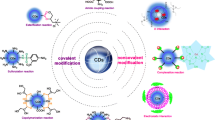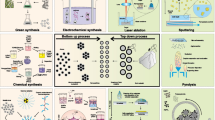Abstract
In this work, the stability of DNA functionalized gold nanoparticles was examined in relation to their size, temperature, as well as the presence of mono- and bivalent ions. Furthermore, we report on the stabilizing effect of an additional post-functionalization with mercaptoalkanes, optionally bearing triethylene glycol (TEG) units. Although such so-called backfilling molecules are commonly used for planar gold surfaces, they have rarely been reported in combination with DNA-functionalized nanoparticles. Our results show that, conform the DLVO theory, smaller citrate-capped gold nanoparticles were more stable towards higher concentrations of salt. Citrate nanoparticles of 30 nm in size were only stable in sodium chloride concentrations up to ~0.05 M and up to 45 °C. The stability of these uncoated nanoparticles was even lower when bivalent salts were used (i.e. <2 × 10−4 M). Immobilization of DNA on these nanoparticles, on the other hand, improved the stability in salt solutions with at least one order of magnitude. The additional use of backfilling molecules stabilized the gold nanoparticles even further, without negatively affecting the DNA hybridization efficiency. DNA functionalization also had a positive impact on the thermal stability of the nanoparticles. Unfortunately, this beneficial effect was not observed after a subsequent backfilling step.






Similar content being viewed by others
References
Bao YP, Huber M, Wei TF, Marla SS, Storhoff JJ, Muller UR (2005) SNP identification in unamplified human genomic DNA with gold nanoparticle probes. Nucleic Acids Res 33(2):e15
Bellino MG, Calvo EJ, Gordillo G (2004) Adsorption kinetics of charged thiols on gold nanoparticles. Phys Chem Chem Phys 6(2):424–428
Blab GA, Cognet L, Berciaud S, Alexandre I, Husar D, Remacle J, Lounis B (2006) Optical readout of gold nanoparticle-based DNA microarrays without silver enhancement. Biophys J 90(1):L13–L15
Bowen WR, Sharif AO (1998) Long-range electrostatic attraction between like-charge spheres in a charged pore. Nature 393:663–666
Campas M, Katakis I (2006) Characterisation and determination of stability and functionality of biofunctionalised colloidal gold nanoparticles. Anal Chim Acta 556(2):306–312
Chowdhury MH, Julian AM, Coates CJ, Cote GL (2004) Detection of differences in oligonucleotide-influenced aggregation of colloidal gold nanoparticles using absorption spectroscopy. J Biomed Opt 9(6):1347–1357
De Palma R, Liu C, Barbagini F, Reekmans G, Bonroy K, Laureyn W, Borghs G, Maes G (2007a) Magnetic particles as labels in bioassays: interactions between a biotinylated gold substrate and streptavidin magnetic particles. J Phys Chem C 111(33):12227–12235
De Palma R, Reekmans G, Laureyn W, Borghs G, Maes G (2007b) The optimization of magnetosandwich assays for the sensitive and specific detection of proteins in serum. Anal Chem 79(19):7540–7548
Dougan JA (2007) Enhanced oligonucleotide–nanoparticle conjugate stability using thioctic acid modified oligonucleotides. Nucleic Acids Res 35(11):3668–3675
Frens G (1973) Controlled nucleation for regulation of particle-size in monodisperse gold suspensions. Nat Phys Sci 241(105):20–22
Gearheart LA, Ploehn HJ, Murphy CJ (2001) Oligonucleotide adsorption to gold nanoparticles: a surface-enhanced Raman spectroscopy study of intrinsically bent DNA. J Phys Chem B 105(50):12609–12615
Hainfeld J, Slatkin DN, Focella TM, Smilowitz HM (2006) Gold nanoparticles: a new X-ray contrast agent. Br J Radiol 79:248–253
Herne TM, Tarlov MJ (1997) Characterization of DNA probes immobilized on gold surfaces. J Am Chem Soc 119:8916–8920
Huang XH, El-Sayed IH, Qian W, El-Sayed MA (2006) Cancer cell imaging and photothermal therapy in the near-infrared region by using gold nanorods. J Am Chem Soc 128(6):2115–2120
Hurst SJ, Lytton-Jean AKR, Mirkin CA (2006) Maximizing DNA loading on a range of gold nanoparticle sizes. Anal Chem 78(24):8313–8318
Jain KK (2005) Nanotechnology in clinical laboratory diagnostics. Clin Chem Acta 358(1–2):37–54
Kalogianni DP, Koraki T, Christopoulos TK, Ioannou PC (2006) Nanoparticle-based DNA biosensor for visual detection of genetically modified organisms. Biosens Bioelectron 21(7):1069–1076
Laaksonen T, Ahonen P, Johans C, Kontturi K (2006) Stability and electrostatics of mercaptoundecanoic acid-capped gold nanoparticles with varying counterion size. Chemphyschem 7(10):2143–2149
Li HX, Rothberg LJ (2004) Label-free colorimetric detection of specific sequences in genomic DNA amplified by the polymerase chain reaction. J Am Chem Soc 126(35):10958–10961
Li Z, Jin RC, Mirkin CA, Letsinger RL (2002) Multiple thiol-anchor capped DNA-gold nanoparticle conjugates. Nucleic Acids Res 30(7):1558–1562
Metcalfe IM, Healy TW (1990) Charge-regulation modelling of the Schulze–Hardy rule and related coagulation effects. Faraday Discuss Chem Soc 90:335–344
Mirkin CA, Letsinger RL, Mucic RC, Storhoff JJ (1996) A DNA-based method for rationally assembling nanoparticles into macroscopic materials. Nature 382(6592):607–609
Paciotti GF, Myer L, Weinreich D, Goia D, Pavel N, McLaughlin RE, Tamarkin L (2004) Colloidal gold: a novel nanoparticle vector for tumor directed drug delivery. Drug Deliv 11(3):169–183
Parak WJ, Pellegrino T, Micheel CM, Gerion D, Williams SC, Alivisatos AP (2003) Conformation of oligonucleotides attached to gold nanocrystals probed by gel electrophoresis. Nano Lett 3(1):33–36
Park S, Brown KA, Hamad-Schifferli K (2004) Changes in oligonucleotide conformation on nanoparticle surfaces by modification with mercaptohexanol. Nano Lett 4(10):1925–1929
Satjapipat M, Sanedrin R, Zhou FM (2001) Selective desorption of alkanethiols in mixed self-assembled monolayers for subsequent oligonucleotide attachment and DNA hybridization. Langmuir 17:7637–7644
Sato K, Hosokawa K, Maeda M (2003) Rapid aggregation of gold nanoparticles induced by non-cross-linking DNA hybridization. J Am Chem Soc 125(27):8102–8103
Sosinsky GE, Giepmans BN, Deerinck TJ, Gaietta GM, Ellisman MH (2007) Markers for correlated light and electron microscopy. Methods Cell Biol 79:575–591
Storhoff JJ, Elghanian R, Mucic RC, Mirkin CA, Letsinger RL (1998) One-pot colorimetric differentiation of polynucleotides with single base imperfections using gold nanoparticle probes. J Am Chem Soc 120(9):1959–1964
Zhao W, Lee TM, Leung SS, Hsing IM (2007) Tunable stabilization of gold nanoparticles in aqueous solutions by mononucleotides. Langmuir 23(13):7143–7147
Acknowledgements
This work was supported by a grant of the Belgian Federal Service of Public Health, Food Chain Safety and Environment (Grant number S-6167). We would like to thank J. Geypen, O. Richard, and H. Bender of IMEC for their work related to the TEM analyses, Dr. F. Degreyse and K. Coorevits of the Laboratory for Soil and Water Pollution (University of Leuven, Belgium) for their help with the ICP-OES measurements, Dr. P. Wattiau and the NEXT colleagues of IMEC for the many fruitful discussions.
Author information
Authors and Affiliations
Corresponding author
Rights and permissions
About this article
Cite this article
Stakenborg, T., Peeters, S., Reekmans, G. et al. Increasing the stability of DNA-functionalized gold nanoparticles using mercaptoalkanes. J Nanopart Res 10 (Suppl 1), 143–152 (2008). https://doi.org/10.1007/s11051-008-9425-9
Received:
Accepted:
Published:
Issue Date:
DOI: https://doi.org/10.1007/s11051-008-9425-9




